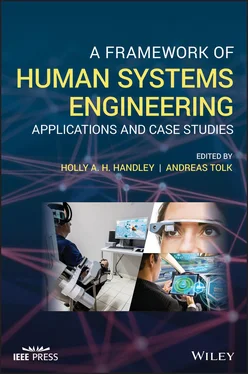5 Chapter 6Figure 6.1 Mercury spacecraft displays and controls.Figure 6.2 Gemini spacecraft displays and controls.Figure 6.3 Apollo command module displays and controls.Figure 6.4 Lunar lander displays and controls.Figure 6.5 Space Shuttle flight deck.Figure 6.6 ISS Cupola workstation.Figure 6.7 Mockup of the Orion D&C glass cockpit.Figure 6.8 NASA HSI domains.Figure 6.9 Notional HSI domain interaction.Figure 6.10 NASA systems engineering engine.Figure 6.11 Notional systems engineering and HSI interaction.Figure 6.12 Notional holistic view of NASA HSI and the SE life cycle.Figure 6.13 Human‐centered design.
6 Chapter 7Figure 7.1 ATC‐to‐ATM evolution from procedural control to trajectory manage...Figure 7.2 The TOP model.Figure 7.3 Example of separability property of a system of systems (SoS). Fo...Figure 7.4 The four loops of automation of the airspace.Figure 7.5 Human‐centered design evolution.Figure 7.6 Procedures, automation, and problem solving leading to the alloca...Figure 7.7 An isolated system.Figure 7.8 A system of systems represented as an infrastructure (i.e. a soci...Figure 7.9 Synthetic view of the system representation.Figure 7.10 A function of functions mapped onto a structure of structures.Figure 7.11 Emerging functions (yellow) and structures (pink) within an acti...Figure 7.12 A function logically transforms a task into an activity.Figure 7.13 HSI recursive definition of a system.
7 Chapter 9Figure 9.1 Resilience attributes' interrelationships.Figure 9.2 DTS resilience driving factors.
8 Chapter 10Figure 10.1 Overview of the data analysis procedure. Notes . ORM, operational...
9 Chapter 11Figure 11.1 The rapid human‐centered systems engineering and human data engi...Figure 11.2 User data interaction design (UDID) of trustworthy blockchain il...Figure 11.3 Distribution of key pairs and certificate.Figure 11.4 Key and CSR generation for ICAs.Figure 11.5 Design of trusted gateways.Figure 11.6 Design of trusted peers and orderers to form a preliminary block...Figure 11.7 Trusted channel among the consortium.Figure 11.8 Systems engineering of human data interaction of the trustworthy...Figure 11.9 Future of human systems engineering trend based on VDMA predicti...Figure 11.10 Future of human systems engineering trend.
10 Chapter 13Figure 13.1 Contemporary control room.Figure 13.2 Future general‐purpose simulator.Figure 13.3 Future on‐site simulatorFigure 13.4 ISA key values.Figure 13.5 NASA‐TLX scales.
1 Cover
2 Table of Contents
3 Begin Reading
1 ii
2 iii
3 iv
4 v
5 xv
6 xvii
7 xviii
8 xix
9 xxi
10 xxii
11 xxiii
12 xxiv
13 1
14 3
15 4
16 5
17 6
18 7
19 8
20 9
21 10
22 11
23 12
24 13
25 14
26 15
27 16
28 17
29 19
30 20
31 21
32 22
33 23
34 24
35 25
36 26
37 27
38 28
39 29
40 30
41 31
42 32
43 33
44 34
45 35
46 36
47 37
48 38
49 39
50 40
51 41
52 43
53 44
54 45
55 46
56 47
57 48
58 49
59 50
60 51
61 52
62 53
63 54
64 55
65 56
66 57
67 58
68 59
69 60
70 61
71 63
72 65
73 66
74 67
75 68
76 69
77 70
78 71
79 72
80 73
81 74
82 75
83 76
84 77
85 78
86 79
87 80
88 81
89 82
90 83
91 84
92 85
93 86
94 87
95 88
96 89
97 90
98 91
99 92
100 93
101 94
102 95
103 96
104 97
105 98
106 99
107 100
108 101
109 102
110 103
111 104
112 105
113 106
114 107
115 108
116 109
117 110
118 111
119 112
120 113
121 114
122 115
123 116
124 117
125 118
126 119
127 120
128 121
129 122
130 123
131 124
132 125
133 126
134 127
135 128
136 129
137 131
138 132
139 133
140 134
141 135
142 136
143 137
144 138
145 139
146 140
147 141
148 143
149 144
150 145
151 146
152 147
153 148
154 149
155 150
156 151
157 152
158 153
159 154
160 155
161 156
162 157
163 158
164 159
165 160
166 161
167 162
168 163
169 164
170 165
171 166
172 167
173 168
174 169
175 170
176 171
177 172
178 173
179 174
180 175
181 176
182 177
183 178
184 179
185 180
186 181
187 182
188 183
189 185
190 186
191 187
192 188
193 189
194 190
195 191
196 192
197 193
198 194
199 195
200 196
201 197
202 198
203 199
204 200
205 201
206 202
207 203
208 204
209 205
210 207
211 208
212 209
213 210
214 211
215 212
216 213
217 214
218 215
219 216
220 217
221 218
222 219
223 220
224 221
225 222
226 223
227 225
228 226
229 227
230 228
231 229
232 230
233 231
234 232
235 233
236 234
237 235
238 236
239 237
240 238
241 239
242 240
243 241
244 242
245 243
246 244
247 245
248 247
249 248
250 249
251 250
252 251
253 252
254 253
255 254
256 255
257 256
258 257
259 258
260 259
261 260
262 261
263 262
264 263
265 264
266 265
267 266
268 267
269 268
270 269
271 271
272 272
273 273
274 274
275 275
IEEE Press445 Hoes Lane Piscataway, NJ 08854
IEEE Press Editorial BoardEkram Hossain, Editor in Chief
| Jón Atli Benediktsson |
David Alan Grier |
Elya B. Joffe |
| Xiaoou Li |
Peter Lian |
Andreas Molisch |
| Saeid Nahavandi |
Jeffrey Reed |
Diomidis Spinellis |
| Sarah Spurgeon |
Ahmet Murat Tekalp |
|
A Framework of Human Systems Engineering
Applications and Case Studies
Edited by
Holly A. H. Handley Andreas Tolk


Copyright © 2021 by The Institute of Electrical and Electronics Engineers, Inc. All rights reserved.
Published by John Wiley & Sons, Inc., Hoboken, New Jersey.
Published simultaneously in Canada.
No part of this publication may be reproduced, stored in a retrieval system, or transmitted in any form or by any means, electronic, mechanical, photocopying, recording, scanning, or otherwise, except as permitted under Section 107 or 108 of the 1976 United States Copyright Act, without either the prior written permission of the Publisher, or authorization through payment of the appropriate per‐copy fee to the Copyright Clearance Center, Inc., 222 Rosewood Drive, Danvers, MA 01923, (978) 750‐8400, fax (978) 750‐4470, or on the web at www.copyright.com. Requests to the Publisher for permission should be addressed to the Permissions Department, John Wiley & Sons, Inc., 111 River Street, Hoboken, NJ 07030, (201) 748‐6011, fax (201) 748‐6008, or online at http://www.wiley.com/go/permissions.
Читать дальше














